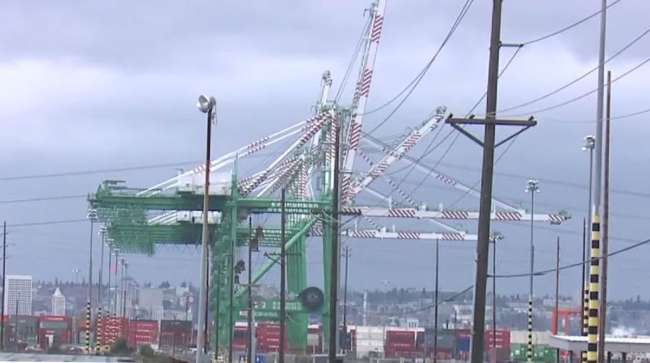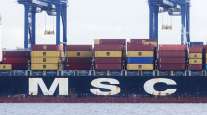Senior Reporter
Higher Container Volumes Signal Strong Start to New Year

[Stay on top of transportation news: Get TTNews in your inbox.]
Both of Southern California's ports reported strong performances in January with container volume surging to pre-pandemic levels.
The Port of Los Angeles notched a 17.9% year-over-year increase, moving 855,652 20-foot-equivalent containers compared with 726,013 in the same month a year ago.
“Two factors are driving our strong start,” Port of Los Angeles Executive Director Gene Seroka said. “First, cargo owners have been replenishing inventories and moving goods at a fast clip ahead of the Lunar New Year holiday. Second, consumer spending and mostly strong economic data continue to accelerate the American economy. Also, last season’s holiday sales grew nearly 4%, with strong job growth and other key indicators trending in a positive direction.”
Long Beach also reported a 17.4% year-over-year increase, processing 674,015 TEUs in January, compared with 573,772 in 2023.
.@PortofLA executive director Gene Seroka is still wary over developments in the #redsea and #panamacanal. @dronantranspo has the interview. #oceanshipping #containership #cargo #supplychain #logistics https://t.co/kWfadih8am — Transport Topics (@TransportTopics) February 27, 2024
“Retailers stocked their warehouses in January ahead of the slower import activity we typically see during Lunar New Year celebrations,” Port of Long Beach CEO Mario Cordero said. “We are ready to grow our volumes and hope to see continued growth through 2024 as we gradually recapture market share.”
Port of Los Angeles starts 2024 with record volume.
Get more on The Bloomberg Intelligence Podcast
On Apple: https://t.co/wSCN8MByZv
On Spotify: https://t.co/Xux1y3LKew
Anywhere: https://t.co/KRMQ71pcWo pic.twitter.com/J4lKgP6hs0 — Bloomberg Radio (@BloombergRadio) February 22, 2024
Cordero added the strong start to 2024 marks the fifth consecutive monthly year-over-year increase after 13 months of declines in cargo movement at the facility.
The Port of Oakland also reported a 4.7% year-over-year increase by handling 187,179 containers compared with 179,228 in the year-ago period.
The @PortofOakland’s January container volume continues its upward trajectory, following a trend first seen in 2023. Full imports increased 8.2%, while full exports saw an increase of 9.3%. Read more: https://t.co/Sp9v1D3sjJ #containervolume #oaklandseaport #containers #seaport pic.twitter.com/1UysckpgnP — Port of Oakland (@PortofOakland) February 26, 2024
The Northwest Seaport Alliance, which operates the ports of Seattle and Tacoma, Wash., reported a 0.8% year-over-year decline, processing 211,283 containers in January compared with 213,085 in 2023.

Guenther
Port Houston notched a 4% year-over-year increase, processing 332,961 containers compared with 319,990 a year ago.
This month, the Texas port announced ZIM Shipping Co.’s new line, Gulf Toucan, is beginning service from the east coast of South America to the Gulf of Mexico and into Houston. It will include eight 2,800-TEU vessels.
“This new service highlights the significant investments we have made in the port’s infrastructure to build capacity, as well as our ongoing growth in Latin American trade,” Port Houston Executive Director Roger Guenther said. “In fact, the trade of containerized goods between Port Houston and Latin America has increased by 33% over the last five years.”
On the East Coast, the Port of Savannah, Ga., reported processing 428,000 TEUs in January, a 1.5% increase from 421,714 in 2023.
South Carolina Port Authority reported a 3.1% year-over-year decline in January to 208,538 TEUs compared with 215,238 a year ago.
NEW RECORDS! PoB handled a record 52.3M tons worth $80B of cargo in 2023!
"PoB continues to prove it's the best port in the nation," @GovWesMoore
PoB also broke records for RoRo machinery, containers & general cargo & finished 1st among all U.S. ports in cars for 13 straight yr. pic.twitter.com/XMQloaugaE — Port of Baltimore (@portofbalt) February 23, 2024
Port of Baltimore announced it intends to become a significantly stronger East Coast competitor for cargo, with the $500 million Howard Street rail tunnel project expected to be completed in 2027. It will allow freight rail carrier CSX to run double-stacked containers from Maine to Florida.
Also, ZIM Shipping Lines recently doubled its service in Baltimore from biweekly to weekly and increased the size of ships servicing the port by 50%. In 2023, the Port of Baltimore said overall TEU volume jumped from 1 million containers to 1.1 million.
Port of Virginia reported January volume falling 4.1% year-over-year to 276,693 TEUs compared with 288,380 the year prior.
The busiest facility on the East Coast, the Port of New York and New Jersey, typically is one month behind other ports in reporting its results. In December, the port saw a 3.4% increase to 633,925 containers compared with 613,011 in 2022.
Want more news? Listen to today's daily briefing below or go here for more info:




